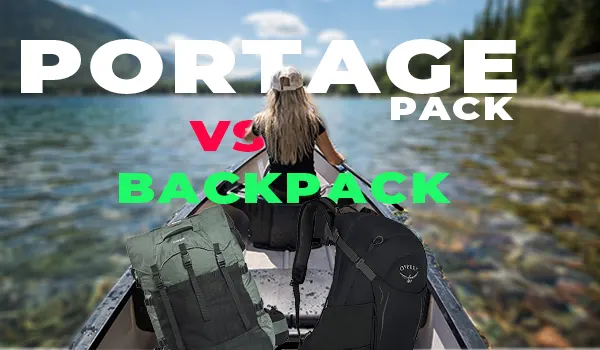If you want to enjoy the wilderness either alone or with a partner then trust me a canoe trip is going to be something that you will remember forever.
Canoe trips allow you to enjoy and experience the wilderness and give you a chance to explore the hinterlands to revive your peace of mind. But This is going to be challenging without a proper carrier.
Many people are confused about either hauling a Portage pack or a traditional backpack for their backcountry canoe trip.
They also argue why invest in a Portage pack, having a hiking backpack already?
Let’s dig deeper to understand, which one is the best a backpack and a Portage pack for your next backcountry canoe trip.
So without further ado
Let’s begin the comparison…
Portage Pack Vs Backpack: Difference & Similarities
Table of Contents
To understand them better I’m going to compare them in terms of their features,
- Weight hauing capacity.
- Comfortness during hauling a heavy load
- How easy or difficult to carry them with a Canoe
Portage Pack
Canoe trips require lots of gear to carry some are small and lightweight and others are bulky. It depends on how long is your trip, the type of trip, and the quantity of gear you are going to carry with you.
Unlike a traditional backpack, a portage pack also called a canoe pack allows you to tote bulky gear in its large volume. Whatever pack you are hauling for your canoe trip, the pack is most often rested under the curve bottom of your canoe. Portage packs are designed to short and squat that rest in the bottom of a canoe without disturbing its center of gravity.
A Portage pack sits low in the canoe that allows you to kneel at the bottom of your canoe when the waves get fierce. Portage packs are unstructured that allowing them to fold in such a way, they can reside in the rounded contour of the bilge.
Even you can achieve a much lower center of gravity by placing a portage pack under the thwarts which might be not possible with a backpack.
Most often Portage pack or canoe pack comes with a single compartment that is lined with heavy-duty plastic material which keeps your gears dry and prevents them get wet.
You will also feel a portage pack sit low on your back and don’t bother you during hauling a canoe over your head.
Disadvantages Of Carrying A Portage Pack Over A Backpack
All these features make a portage pack perfect for a canoe trip, but apart from several juicy things about a portage pack or a canoe pack, your taste will be bitter when you slog a portage.
Backpack
Many people have this mindset,
Why spend on a Portage pack when I have a hiking backpack?
I’m not going to buy a canoe pack, for my backcountry canoe trip.
You are probably wrong in this case. Let me clarify why…
A backpack is the best carrier for your hiking, camping, and other trails adventurous trip where you need to walk on a tough trail for hours. In this scenario having a backpack, with a better internal frame, comfortable shoulder straps, and ventilated mesh back is paramount.
A backcountry canoe trip is quite different. Here, most of the time a canoe pack rests in the curve bottom of your canoe so how a pack is stashed in your canoe is paramount.
Usually hiking or camping backpacking packs are tall and come with rigid structures both inside and outside. This steady structure forced it to sit tall if you keep it in your canoe.
This is very bad to maintain the stability of your canoe because it raises the center of gravity of a canoe. The situation is going too bad if it is a windy day.
Problems You Will Face When You Place Your Backpack On A Canoe
It is clear that most of your time is going on the canoe. The problems arise when you try to lay your backpack flat to maintain the center of gravity. It causes your backpack straps and back to become wet due to bilge water.
Also, the frame structure of your backpack prevents it from pushing under the contour of the canoe.
Maybe you think to lay your backpack frame side up.
It would have been a good idea, but the water would find its way to get into the backpack.
Another big problem with your backpack is, having lots of pockets and external straps which are enough to snag the canoe.
A backpack has lots of separate compartments and external pockets, not all of them waterproof. Every time you will face problems and it is a headache to load and unload your backpack at a portage.
Backpack Vs Portage Pack (Canoe Pack): Which One Is Best?
Choosing a backpack or a portage pack totally depends on the nature of the trip, the number of gear you want to carry, and how much you are willing to pay.
For a canoeing trip, it is recommended to go with a portage pack due to its several advantages. Its small and unstructured design makes it easy to stash in the curve bottom of the canoe.
On the other hand, a backpack comes with a large capacity and several internal and external pockets which raises the center of gravity of the canoe and causes instability.
The backpack provides a more comfortable way to haul heavy loads but here, a pack that can rest on a canoe and on the water is paramount because most of the water boundaries are about 1/2 or 1/4 miles long and don’t require carrying a pack on your back for hours.
FAQ
Q.1 What Is Portage Pack And How It Is Different From A Traditional Backpack?
A portage pack is specially designed for a canoe adventure trip. Canoe adventure trips require a small, and unstructured pack that can be stashed in the contours of the blige.
Some qualities of a Portage pack:
1. small and unstructured design.
2. One waterproof compartment for your gear.
3. Easy to stash on your canoe.
4. Maintain the stability and lower the center of gravity of the canoe.
5. Sit lower on your back and you can carry it during portaging.


![Read more about the article Best Backpack For Canoe Trip 2023:[Latest]](https://backpacksidea.com/wp-content/uploads/2022/02/best-backpack-for-canoeing-trip.webp)

